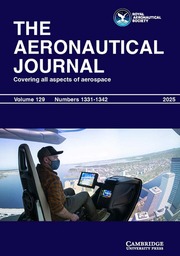Article contents
Structural dynamics-CFD interaction forcomputation of vertical tail buffet
Published online by Cambridge University Press: 04 July 2016
Abstract
The multidisciplinary problem of tail buffeting issolved using three sets of equations. The first setis the unsteady, compressible, full Navier-Stokesequations which are used for obtaining the flowfieldvector and the aerodynamic loads. The second set isthe coupled aeroelastic equations which are used forobtaining the bending and torsional deflections ofthe tail. The third set is the grid-displacementequations which are used for updating the gridcoordinates due to the tail deflections. For thecomputational applications, a sharp-edged delta wingof aspect ratio one and a rectangular vertical tailof aspect ratio one placed in the plane of geometricsymmetry behind the wing are considered. Theconfiguration is pitched at a critical angle ofattack (α = 38°) which produces asymmetric,vortex-breakdown flow from the delta wing primaryvortices. The results show the effects of coupledand uncoupled bending-torsional responses and theeffects of Reynolds number.
Information
- Type
- Research Article
- Information
- Copyright
- Copyright © Royal Aeronautical Society 1996
References
- 6
- Cited by

